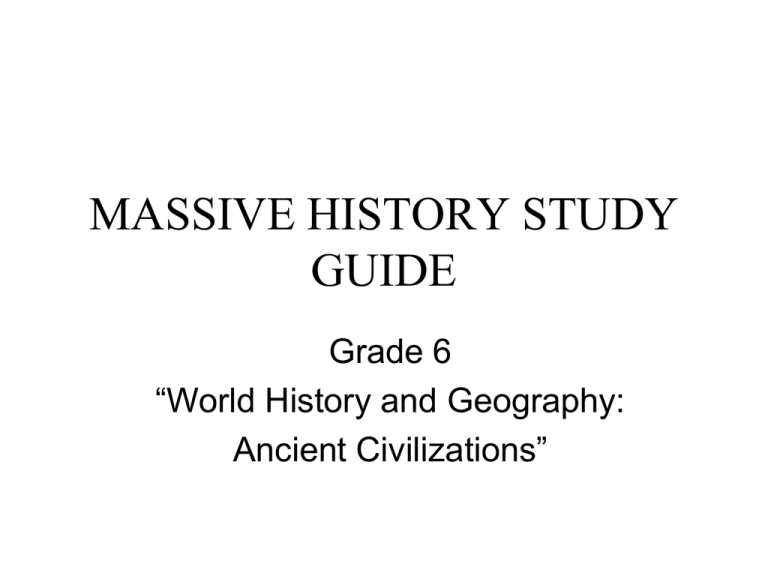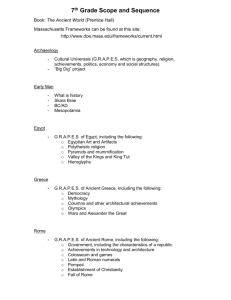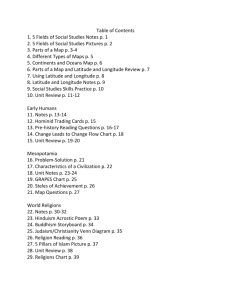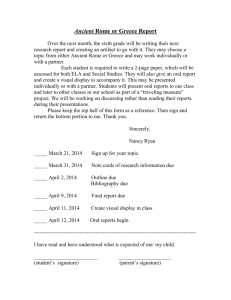MASSIVE HISTORY STUDY GUIDE!
advertisement

MASSIVE HISTORY STUDY GUIDE Grade 6 “World History and Geography: Ancient Civilizations” Grade 6 “World History & Geography: Ancient Civilizations” • Archaeological studies of the early physical & cultural development of humankind from the Paleolithic era to the agricultural revolution. Study Guide a. Hunter-gatherer societies – Development of tools & use of fire b. Locations – Africa, the Americas, China, EGYPT, Greece, Israel, Mesopotamia, Persia, Rome Climate Changes Climatic changes & human modifications of the physical environment which gives rise to the domestication of plants and animals & adds new sources of clothing and shelter a. Slash & burn agriculture – rip up the land and burn it so to have fresh soil to grow crops b. Turn from food gathering to food producing c. Domestication of dogs & sheep d. Permanent settlements – crude mud houses A. Mesopotamia a. Off the Tigris & Euphrates River Systems, Migration of northern farmers settle in region from Babylon to Persian Gulf b.Wheat grown from seed, herds of goats, sheep, and pigs. c. Ubaidians develop first divisions of labor, mud brick villages, first religious shrines d.2750 - Gilgamesh, hero of Sumerian legends, reigns as king of Erech A. Mesopotamia e. The earliest writing in Mesopotamia was a picture writing invented by the Sumerians who wrote on clay tablets using long reeds. The script the Sumerians invented and handed down to the Semitic peoples who conquered Mesopotamia in later centuries, is called cuneiform, which is derived from two Latin words: cuneus , which means "wedge," and forma , which means "shape." This picture language, similar to but more abstract than Egyptian hieroglyphics, eventually developed into a syllabic alphabet under the Semites (Assyrians and Babylonians) who eventually came to dominate the area. A. Mesopotamia f. Hammurabi (as King) combined astute diplomacy and military leadership; he defeated Rim-Sin, as well as the kings of Elam, Mari, and Eshnunna, and about 1760 BC became the ruler of a united kingdom extending from the Persian Gulf to the Habur River. The history of Babylonia (the world's first metropolis) is considered to begin with Hammurabi. An unusually active and capable administrator, Hammurabi gave his personal attention to such details as the cleaning of irrigation canals and the insertion of an extra month into the calendar. He was an outstanding lawgiver; the Code of Hammurabi is one of the most significant legal documents ever uncovered. He was also an inspiring religious leader; during his reign the Babylonian city god Marduk became a recognized leader in the pantheon of deities. A. Mesopotamia f. Hammurabi – By far the most remarkable of the Hammurabi records is his code of laws, the earliest-known example of a ruler proclaiming publicly to his people an entire body of laws, arranged in orderly groups, so that all men might read and know what was required of them. The code was carved upon a black stone monument, eight feet high, and clearly intended to be reared in public view. This noted stone was found in the year 1901, not in Babylon, but in a city of the Persian mountains, to which some later conqueror must have carried it in triumph. It begins and ends with addresses to the gods. Even a law code was in those days regarded as a subject for prayer, though the prayers here are chiefly cursings of whoever shall neglect or destroy the law. “AN EYE FOR AN EYE” B. Egypt In Africa near the Nile a. Art & Architecture i. Of the materials used by the Egyptian sculptor -clay, wood, metal, ivory, and stone -- stone was the most plentiful and permanent, available in a wide variety of colors and hardness. Sculpture was often painted in vivid hues as well. Egyptian sculpture has two qualities that are distinctive; it can be characterized as cubic and frontal B. Egypt b. Belief in the Afterlife i. The need to preserve the body from decay was probably the most important part of the Egyptian belief in a life after death because the spirit was thought to inhabit it at times. In the Predynastic period before 3,000 B.C. and the beginning of the Pharonic Age, the body was placed in a grave in the sand with some simple offerings. The natural heat and dryness preserved it with little need for embalming or other preparation. As society developed in Egypt and tombs became much more elaborate, it was necessary to treat the body to protect it from decay. B. Egypt ii. The removed internal organs were separately treated and, during much of Egyptian history, placed in jars of clay or stone. These so-called Canopic Jars were closed with stoppers fashioned in the shape of four heads -- human, baboon, falcon, and jackal -- representing the four protective spirits called the Four Sons of Horus B. Egypt iii. The Egyptians believed that the next life had to be provided for in every detail and, as a result, tombs were decorated with depictions of the deceased at his funerary meal, activities of the estate and countryside, and the abundant offerings necessary to sustain the spirit B. Egypt iv. In the religion of ancient Egypt deities were associated with various aspects of nature and the cosmos, particular geographical localities, or even episodes in human experience such as birth and death. Osiris, originally a god of vegetation and fecundity, was the most important deity related to the afterlife. His wife, Isis, was his principal mourner but also served as an image of motherhood. Some deities had animals associated with them and some were depicted as having animal characteristics. The ibis-headed god Thoth, as an example, was the patron of scribes and writing as well as being a moon god B. Egypt v. Queen Hatshepsut rise to power went against all the conventions of her time. She was the first wife and Queen of Thutmose II and on his death proclaimed herself Pharaoh, denying the old king's son, her nephew, his inheritance. To support her cause she claimed the God Amon-Ra spoke, saying "welcome my sweet daughter, my favourite, the king of Upper and Lower Egypt, Maatkare,Hatshepsut. B. Egypt v. Thou art the King, taking possession of the Two Lands." She dressed as a king, even wearing a false beard and the Egyptian people seem to have accepted this unprecedented behaviour. She remained in power for twenty years and during this time the Egyptian economy flourished, she expanded trading relations and built magnificent temples as well as restoring many others B. Egypt vi. Ramses (the GREAT) II was an ancient Egyptian king, third ruler of the 19th Dynasty, the son of Seti I. During the early part of his reign Ramses fought to regain the territory in Africa and western Asia that Egypt had held during the 16th and 15th centuries BC. His principal opponents were the Hittites, a powerful people of Asia Minor, against whom he waged a long war. B. Egypt vi. The major battle of this war was fought in 1274 at Kadesh, in northern Syria, and in 1258 BC a treaty was signed whereby the contested lands were divided and Ramses agreed to marry the daughter of the Hittite king. The remaining years of his rule were distinguished by construction of such monuments as the rock-hewn temple of Abu Simbel, the great hypostyle hall in the Temple of Amon at Karnak, and the mortuary temple at Thebes, known as the Ramesseum C. Kush i. Kush, the Egyptian name for ancient Nubia, was the site of a highly advanced, ancient black African civilization that rivaled ancient Egypt in wealth, power and cultural development. The first capital of Kush lay at Kerma just south of the Third Cataract of the Nile. Here dwelt powerful and wealthy black kings who controlled the trade routes connecting central Africa with ancient Egypt. C. Kush a. The Egyptians, who had few natural resources of their own, sought the precious, exotic products of central Africa to satisfy the demands of their luxuryloving populace. By about 1500 B.C., the Egyptians, feeling threatened by the Nubian kings, invaded Kush and conquered it. For the next four centuries, the Egyptians exploited Kush as a colony. Egypt's wealth in gold came from the desert mines of Kush. The Egyptian word for gold is nub, which is thought by some to be the origin of the name Nubia D. Ancient Hebrews a. Judaism – first monotheistic religion (belief in only one God) i. Belief in God, observance of law, practice of the concepts of righteousness & justice, importance of study ii. Abraham (Abraham is said to be the first person to accept a covenant, or contract, with God), Moses (the prophet Moses first recorded the Torah, the Jewish holy text), Naomi, Ruth, David, & Yohanan ben Zaccai D. Ancient Hebrews iii. According to the Bible, Abraham is born in the city of Ur in southern Mesopotamia and brings his family to Canaan. Abraham's son Isaac remains in Canaan his entire life. During a famine, Issac's son Jacob moves to Egypt with his entire family and their possessions. Exodus from Egypt. According to the Bible, Moses leads the people of Israel out of slavery in Egypt. An essential story for the Jewish people, the Exodus is commemorated through the festival of Passover. Shortly after the Exodus, the nation receives the Torah at Sinai D. Ancient Hebrews iv. 70 AD Titus, son of the Roman Emperor Vespasian, destroys Jerusalem and the Second Temple. Jews are sold into slavery and sent into exile. The synagogue begins to play a central role in Jewish life. D. Ancient Hebrews b.One of the most spectacular finds in the Cave of Letters was a packet of personal documents that belonged to a young Jewish woman named Babatha. Probably born around A.D. 104, Babatha became a woman of means who, by the time of her death around 132, owned valuable properties left to her by her father and her two husbands E. Ancient Greece a. Development of city-states in the region of the Aegean Sea b. Transition from tyranny (dictatorship) to oligarchy (Government by a few, especially by a small faction of persons or families) E. Ancient Greece c. Significance of the invention of the idea of citizenship – Pericles’ Funeral Oration - In 431, shortly after the Peloponnesian War had broken out, Pericles delivered his famous Funeral Oration to commemorate those troops who had already fallen in battle. Recorded, and probably rewritten by the historian Thucydides, it is one of the primary sources on which our understanding of ancient Athens is based and provides a unique insight into just how Athenian democracy understood itself. In the speech Pericles relates the special qualities of the Athenians, redefining many traditional Greek virtues in a radical new light. E. Ancient Greece d. Athenian Democracy vs. Representative Democracy i. In modern direct democracy the people are given the right to pass laws, veto laws and withdraw support from an elected representative. Modern direct democracy is characterized by three pillars ii. Representative democracy is a broad term describing a means of governance by the people through elected representatives. The people elect government officials who then make decisions and enact laws on their behalf. E. Ancient Greece e. Greek Mythology – still used today i. Homer’s Iliad & Odyssey ii. Aesop’s fables E. Ancient Greece f. Athens & Sparta i. Athens had been occupied from 3,000 BC onward, but not until the height of Mycenaean rule (1,400 BC to 1,200 BC), did the city begin to create the buildings commonly associated with it. Originally situated on the rocky mount known as the Acropolis, the city began to spread southward. As Athens expanded physically, so too did it expand from a political standpoint. As the Durians and the Greek Dark Ages began to slowly relinquish their hold upon Greece, a change in political thought came to Athens. The aristocratic families which had lost most of their power due to the monarchy of the Dark Ages, elected a statesman who would represent the city for one year. This practice carried on to create a democratic tradition within Greece, the remnant of which still serves as a model within the present E. Ancient Greece ii. Sparta - Unlike Athens, Sparta was a military oligarchy, monarchy, democracy, and timocracy all rolled into one. Originally founded with aristocratic interest, Sparta managed to keep its lineage of kings through out its existence. The kings themselves came from two great aristocratic houses. From these two great houses and the aristocratic influence of early Sparta, the city survived under the edict of "dependence of the small on the great." E. Ancient Greece g. Alexander the Great - Alexander was called "the great" because he conquered lots and lots of land. According to this page in our Persian Wars category, Alexander (336-323 BC) became king of Greece at age 20, then proceeded to conquer most of the western world. At its height, Alexander's empire included all of Europe, most of Asia, and big huge chunks of Africa. He actually planned to make Asia and Europe one country, with him as its ruler! h. Important Greek figures – Hypatia, Socrates, Plato, Aristotle, Euclid, Thucydides F. India – Indus Valley a. Nomadic Aryans invaded India ca. 1500 BC destroying the Indus valley civilization and exterminating the Indus inhabitants. Thus ended the most brilliant civilization of the ancient world. Subsequent to this invasion, India was plunged into 2000 years of the Vedic Dark Ages. When cities were built again, it was under Scytho-Greek influence. The ziggurat of the Indus disappeared forever F. India – Indus Valley b. Brahmanism the religious and social system of the Brahmans and orthodox Hindus, characterized by the caste system and diversified pantheism c. The Indian caste system has been in use for many years. Still today the values of the caste system are held strongly. It has kept a sense of order, and peace among the people. There are five different levels of the system: Brahman, Kshatriya, Vaishya, Shudra, and Harijans. Within each of these categories are the actual "castes" or jatis within which people are born, marry, and die. They all have their own place among each other and accept that it is the way to keep society from disintegrating to chaos F. India – Indus Valley d. Buddha - In about the sixth century B.C. Siddhartha Gautama was born into a royal family. When he was a young adult his experiences with the outside world drove him to seek out a greater understanding of life and spiritual fulfillment. Through seeking guidance and meditation, Siddhartha achieved Enlightenment. From that point, he was known as the Buddha, which means 'Enlightened One'. For the rest of his life, the Buddha traveled great distances teaching people about one path to salvation. Believed in afterlife. e. Maurya empire - was India's first great unified empire. It lasted from 321 to 185 BCE, and was ruled by the Mauryan dynasty. At its height it ruled virtually all of northern and central India and even parts of Afghanistan and Pakistan F. India – Indus Valley f. Asoka - Ashoka the Great (also Asoka, Aśoka, pronounced as Ashok-uh, not Ashokaa) was the ruler of the Mauryan empire from 273 BC to 232 BC. A convert to Buddhism, Ashoka reigned over most of the Indian subcontinent, from present day Afghanistan to Bengal and as far south as Mysore F. India – Indus Valley g. Sanskrit literature - Literature in Sanskrit, India's oldest language, and the mother language of several modern languages in India. Given its extensive use in religious literature, primarily of Hinduism, and the fact that most modern Indian languages have been directly derived from or strongly influenced by Sanskrit, it is not surprising that the position of Sanskrit in Indian culture is not unlike that of Latin in European culture i. Bhagavad-Gita Gita - meaning "song of the Lord", refers to itself as a 'Yoga Upanishad' and is sometimes called Gītopanişad. It is believed to be the only known religious text to have been spoken by God or an incarnation/ avatar of God directly F. India – Indus Valley h. Idea of the number ZERO G. China a. Confucius - is a moral and religious system from China started by Kongfuzi, under the Pinyin system, c.551-479 B.C., Chinese sage more commonly known as Confucius, who created sayings known as the Analects and other ancient commentaries. These moral concepts taught how to treat other people. G. China b. This was similar to the Golden Rule. Confucianism, with these practical social concepts, was surpassed by Buddhism from the 3rd to 7th century A.D., Confucianism had a revival under the Tang Dynasty of China (618-907). The Song Dynasty (960-1279) developed a modified version of Confucianism, based on beliefs of Zen Buddhism and during the Ming Dynasty, under the Pinyin system, (1368-1644) meditation became a part of Confucianism. With the overthrow of the monarchy in 1911-12, Confucianism declined. G. China c. Qin Shi Huang (November or December 260 BC - September 10, 210 BC), personal name Zheng, was king of the Chinese State of Qin from 247 BC to 221 BC, and then the first emperor of a unified China from 221 BC to 210 BC, ruling under the name First Emperor. Having unified China, he and his prime minister Li Si passed a series of major reforms aimed at cementing the unification, and they undertook some Herculean construction projects, most notably the precursor version of the current Great Wall of China. For all the tyranny of his autocratic rule, Qin Shi Huang is still regarded today as some sort of a colossal founding father in Chinese history whose unification of China has endured for more than two millennia (with interruptions). G. China d. Han Dynasty - The Han Dynasty (Traditional Chinese: Simplified Chinese: Pinyin: Hàncháo; 202 BC - AD 220) followed the Qin Dynasty and preceded the Three Kingdoms in China. During the Han Dynasty, China officially became a Confucian state and prospered domestically: agriculture, handicrafts and commerce flourished, and the population reached 50 million. Meanwhile, the empire extended its political and cultural influence over Vietnam, Central Asia, Mongolia, and Korea before it finally collapsed under a combination of domestic and external pressures G. China e. The Silk Road is the ancient trade route passing from the shores of the Mediterranean through Bukhara and Samarkand to Dunhuang and on to Xian in central China. Silks, spices and perfumes, precious gems such as amber and coral, and all manner of commodities traveled along this route. But the Silk Road also transported cultural influences knowledge and ideas, customs and religions, art and science. G. China e. During four major expeditions on the Eastern Silk Road between 1900 and 1930, Stein journeyed across the area between the Pamirs and China several times, discovering tens of thousands of manuscripts, paintings and artifacts dating from the second century BC to the 15th century AD. H. Rome a. How Rome got its name - Rome is the capital city of Italy. Building started in 753 B.C. and the Romans have a story to explain how this happened. Twin boys, Romulus and Remus, were taken from their mother and left by the river Tiber to starve. A mother wolf found the babies and looked after them until they were old enough to take care of themselves. H. Rome a. Years later, Mars (the Roman God of war) told the boys to build a city where they had been found. The two boys built this city, but ended up at war with each other. Romulus won the battle and the city became known as Rome. Today, historians and archaeologists agree that people started living in Rome long before the time of Romulus and Remus, but many people still believe in their legend H. Rome b.How Rome was ruled - At first, Rome was ruled by kings. They were sometimes very cruel and the last king, Tarquin the Proud, was overthrown. Rome then became a republic for the next four hundred years. This republic was ruled by a senate, and people called Senators were elected to do different jobs in the senate. H. Rome b. However, not everyone was allowed to vote in these elections. Women and slaves were not allowed to vote and neither were poor people. Those Roman people who were not slaves were called 'citizens'. In the 1st century B.C. the generals who controlled the army became very powerful. Rome was no longer just a city, it was the capital of an empire. The Romans ruled lands from France to North Africa H. Rome c. Who were Roman Emperors - A Roman Emperor was the man who ruled over the Empire. At first, Rome was ruled by Generals but this caused problems. The Generals were always fighting over who would have the final say in running the Empire. Eventually the Generals were replaced by just one man - The Emperor. H. Rome c. The first Emperor to come to power was Augustus in 27 B.C (Before this, we had Julius Caesar with his idea of a republic). He was a popular Emperor who brought peace after many years of fighting. Not all the Emperors were so good and wise, some were terrible! The Emperor had a troop of special soldiers to protect him. They were called the Praetorian Guard. However, some of the bad Emperors were so unpopular that their Praetorian Guards killed them







